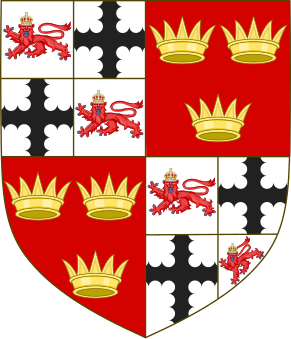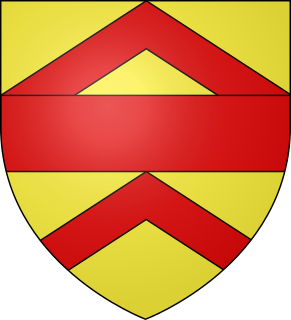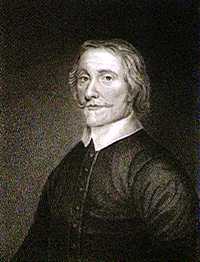
Viscount Cobham is a title in the Peerage of Great Britain that was created in 1718. Owing to its special remainder, the title has passed through several families. Since 1889, it has been held by members of the Lyttelton family.

Earl of Abingdon is a title in the Peerage of England. It was created on 30 November 1682 for James Bertie, 5th Baron Norreys of Rycote. He was the eldest son of Montagu Bertie, 2nd Earl of Lindsey by his second marriage to Bridget, 4th Baroness Norreys de Rycote, and the younger half-brother of Robert Bertie, 3rd Earl of Lindsey. His mother's family descended from Sir Henry Norris, who represented Berkshire and Oxfordshire in the House of Commons and served as Ambassador to France. In 1572 he was summoned by writ to Parliament as Lord Norreys de Rycote. He was succeeded by his grandson, the second Baron. In 1621 he was created Viscount Thame and Earl of Berkshire in the Peerage of England. He had no sons and on his death in 1624 the viscountcy and earldom became extinct. He was succeeded in the barony by his daughter Elizabeth, the third holder of the title. On her death the title passed to her daughter, the aforementioned Bridget, the fourth Baroness, second wife of the second Earl of Lindsey.

Earl of Seafield is a title in the Peerage of Scotland. It was created in 1701 for James Ogilvy, who in 1711 succeeded his father as 4th Earl of Findlater. The earldoms of Findlater and Seafield continued to be united until 1811, when the earldom of Findlater became dormant, while the earldom of Seafield remains extant.

Baron FitzWalter is an ancient title in the Peerage of England. It was created on 24 June 1295 for Robert FitzWalter. The title was created by writ, which means that it can descend through both male and female lines. His great-grandson, the fourth baron, was an Admiral of the Fleet. The fourth baron's grandson, the sixth baron, died from dysentry at the siege of Harfleur. He was succeeded by his brother, the seventh baron, who in turn was succeeded by his daughter and only child, Elizabeth. She was the wife of John Radcliffe. Their son, the ninth baron, was attainted for treason in 1495 with his title forfeited. However, his son Robert Radcliffe obtained a reversal of the attainder by Act of Parliament in 1509 and later served as Lord Lieutenant of Lancashire. He was created Viscount FitzWalter in 1525 and Earl of Sussex in 1529. His grandson, the third earl, was summoned to the House of Lords through a writ of acceleration in 1553 in his father's junior title of Baron FitzWalter. Lord Sussex later served as Lord Deputy of Ireland. He was succeeded by his younger brother, the fourth earl. He had earlier represented Maldon, Hampshire and Portsmouth in the House of Commons and also served as Lord Lieutenant of Hampshire. When he died the titles passed to his only child, the fifth earl. He was Lord Lieutenant of Essex.

Earl of Macclesfield is a title that has been created twice. The first creation came in the Peerage of England in 1679 in favour of the soldier and politician Charles Gerard, 1st Baron Gerard. He had already been created Baron Gerard, of Brandon in the County of Suffolk, in 1645, and was made Viscount Brandon, of Brandon in the County of Suffolk, at the same time as he was given the earldom. These titles are also in the Peerage of England. Lord Macclesfield was the great-grandson of the distinguished judge Sir Gilbert Gerard, Master of the Rolls from 1581 to 1594. He was succeeded by his eldest son, the second Earl. He was involved in the Rye House Plot of 1683, was sentenced to death but later pardoned by the King. On his death without legitimate issue in 1701 the titles passed to his younger brother, the third Earl. He had earlier represented Yarmouth, Lancaster and Lancashire in the House of Commons. When he died in 1702 the titles became extinct.

Earl of Chichester is a title that has been created three times, twice in the Peerage of England and once in the Peerage of the United Kingdom. The current title was created in the Peerage of the United Kingdom in 1801 for Thomas Pelham, 2nd Baron Pelham of Stanmer.

Earl of Strafford is a title that has been created three times in English and British history.

Viscount Valentia is a title in the Peerage of Ireland. It has been created twice. The first creation came in 1621 for Henry Power. A year later, his kinsman Sir Francis Annesley, 1st Baronet, was given a "reversionary grant" of the viscountcy, which stated that on Power's death Annesley would be created Viscount Valentia. Annesley, a member of an influential Anglo-Irish family which descended from Newport Pagnell in the County of Buckinghamshire, was a favourite of James I, who granted him land in Ireland, notably the fort of Mountnorris in County Armagh. He was knighted in 1616, created a baronet, of Newport Pagnell in the County of Buckingham, in the Baronetage of Ireland in 1620 and Baron Mountnorris, of Mountnorris in the County of Armagh, in 1628.
Earl Rivers was an English title, which has been created three times in the Peerage of England. It was held in succession by the families of Woodville, Darcy and Savage.
The title Earl of Bolingbroke has been created twice, once in the Peerage of England and once in the Jacobite Peerage.
The Baronetcy of Temple, of Stowe, in the Baronetage of England, was created on 24 September 1611 for Thomas Temple, eldest son of John Temple of Stowe, Buckinghamshire. His great-grandson Sir Richard, 4th Baronet, was created Baron Cobham on 19 October 1714, and Viscount Cobham and Baron Cobham on 23 May 1718, the latter with a special remainder, failing his male issue to his sisters and their heirs male. Upon his death on 13 September 1749, the barony of 1714 became extinct, the viscountcy and barony of 1718 passed to his elder sister, and the baronetcy passed to his second cousin once removed William Temple, of Nash House, who became 5th Baronet. On the death of Sir William's nephew Sir Richard Temple, 7th Baronet, on 15 November 1786, the baronetcy became dormant.
Earl of Sussex is a title that has been created several times in the Peerages of England, Great Britain, and the United Kingdom. The early Earls of Arundel were often also called Earls of Sussex.
Viscount O'Neill, of Shane's Castle in the County of Antrim, was a title in the Peerage of Ireland. It was created in 1795 for John O'Neill, 1st Baron O'Neill, who had earlier represented Randalstown and County Antrim in the Irish House of Commons. He had already been created Baron O'Neill, of Shane's Castle in the County of Antrim, in 1793, also in the Peerage of Ireland. He died in 1798 and was succeeded by his son, the second Viscount. In 1800 he was created Viscount Raymond and Earl O'Neill in the Peerage of Ireland. The same year he was elected as one of the original 28 Irish Representative Peers. The viscountcy of Raymond and earldom became extinct on his death in 1841. The barony and viscountcy of O'Neill were passed on to his only brother, the third Viscount. These titles became extinct on the latter's death in 1855. The late Viscount's estates were inherited by his cousin, the Reverend William Chichester, who assumed the surname of O'Neill in lieu of Chichester the same year. In 1868, the O'Neill title was revived when he was created Baron O'Neill. This title is still extant.

Viscount FitzWilliam, of Merrion in the County of Dublin, was a title in the Peerage of Ireland. It was created in 1629 for Thomas FitzWilliam, along with the subsidiary title Baron FitzWilliam, of Thorncastle in the County of Dublin, also in the Peerage of Ireland. He was succeeded by his son Oliver, the second Viscount. In 1661 Oliver was created Earl of Tyrconnell in the Peerage of Ireland. The earldom became extinct on his death in 1667, but he was succeeded in the barony and viscountcy by his younger brother William FitzWilliam, the third Viscount. William's grandson Richard, the fifth Viscount, represented Fowey in the British Parliament. His son Richard, the sixth Viscount, was a member of both the Irish and English Privy Councils. The seventh Viscount was a benefactor and musical antiquarian. The titles became extinct on the death of the ninth Viscount in 1833.
Baron Ranelagh, of Ranelagh in the County of Wicklow, was a title in the Peerage of Ireland. It was created on 18 April 1715 for Sir Arthur Cole, 2nd Baronet, who had earlier represented Enniskillen and Roscommon Borough in the Irish House of Commons. The Baronetcy, of Newland in the County of Dublin, was created in the Baronetage of Ireland in 1660 for his father John Cole, a member of the Irish Parliament for County Fermanagh. He married Elizabeth Chichester, daughter of Lieutenant-Colonel John Chichester and the Honourable Mary Jones, daughter of Roger Jones, 1st Viscount Ranelagh, and aunt of Richard Jones, 1st Earl of Ranelagh. Lord Ranelagh was childless and the titles became extinct on his death in 1754.

Richard Jones, 1st Earl of Ranelagh, known as The Viscount Ranelagh between 1669 and 1677, was an Irish peer, politician both in the Parliaments of England and Ireland.
Sir Roger Jones, 1st Viscount RanelaghPC (Ire) was joint Lord President of Connaught with Charles Wilmot, 1st Viscount Wilmot. He commanded the forces of the Irish Army in Connaught during the early years of the Irish Confederate Wars and defended Athlone against confederate troops under James Dillon.
There have been two baronetcies created for persons with the surname Yelverton, both in the Baronetage of England.
Arthur Cole, 1st Baron Ranelagh, known as Sir Arthur Cole, Bt, between c. 1691 and 1715, was an Irish politician.
Sir John Cole, 1st Baronet was an Anglo-Irish politician.






